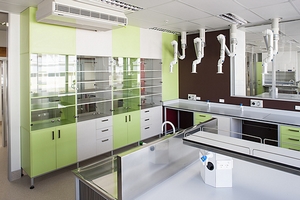Scion laboratories world class
21 June 2013
 The architects behind Crown Research Institute Scion’s recently upgraded Orman Wing laboratories, Lab-works Architects, have received international recognition for their design of the building.
The architects behind Crown Research Institute Scion’s recently upgraded Orman Wing laboratories, Lab-works Architects, have received international recognition for their design of the building.
Lab-works won the International Laboratory Buildings category of the S-Lab International Design Awards, announced this week at the S-Lab Conference and Awards in Liverpool, England. The award recognises architectural and functional elements of laboratory design, including environmental aspects, materials used, energy efficiency and long term sustainability.
“We’re delighted that Lab-works have received this award,” says Scion CEO Dr Warren Parker. “And we are very proud of these world-class laboratories.
“High quality facilities and equipment and an attractive work environment are vital to the success of a science organisation. These state-of-the-art laboratories provide an open, collaborative space where our scientists can enjoy natural light, and safe working conditions. This ensures we can continue to provide internationally competitive science to the New Zealand forest industry and the rapidly developing biomaterials sector.”
The $5.5 million upgrade at Scion’s Rotorua campus, saw the redesign and refurbishment of laboratories that had been largely unchanged since they built in 1969. The project, completed in August last year, was opened by the Minister of Science and Innovation, Hon Steven Joyce on 31 October 2012.
The Orman Wing laboratories consist of 1500 square metres of open plan cross-disciplinary spaces where specialty areas are grouped together for better use of staff time and equipment. Clever design has created a larger working area, and air-conditioning and double glazing mean the environmental footprint of the building has been considerably reduced. The design also incorporates innovative storage and safety features; and integration with the campus landscape.
The laboratories have a glazed walkway along the length of the building that allows visitors to view science in action while remaining outside. This helps maintain high operating standards at all times, particularly in areas designed for physical containment of biological material.
The Orman Wing is named after the late Roy Orman who led forest products research at the, then, Forest Research Institute from 1950 to 1980. Mr Orman’s legacy was to create a world-class wood products research organisation in New Zealand.
The S-Lab programme, (Safe, Successful, Sustainable Laboratories) is a UK based initiative designed to highlight best practice among those involved in laboratory design, operation and management. This year is the first to include an international category.
-ends-
